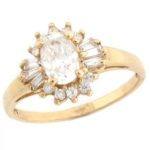Fine gold jewelry is a timeless investment that can be passed down for generations. But before you make a purchase, it's important to understand the key aspects of fine gold jewelry. Here are five essential facts to help you make an informed decision:
**1. Karatage: Measuring Gold Purity**
Karatage is a measure of gold's purity, expressed in karats (abbreviated as "K"). Pure gold is 24 karats, but fine gold jewelry is typically made of gold alloys to enhance its durability and color. Common karatages for jewelry include 18K (75% gold), 14K (58.3% gold), and 10K (41.7% gold).
**2. Gold Color: Variations and Alloys**
Gold naturally occurs in a yellow hue, but it can be alloyed with other metals to create different colors. White gold is created by mixing gold with palladium or nickel, while rose gold is achieved by adding copper. Green gold is a result of adding silver or zinc, and black gold is produced using rhodium plating.
**3. Design and Craftsmanship: Artistic Expression**
Fine gold jewelry encompasses a wide range of designs, from classic to contemporary. The craftsmanship involved in creating these pieces is intricate and often requires specialized skills. Goldsmiths use various techniques such as casting, forging, and stone setting to bring their designs to life.
**4. Durability and Longevity**
Gold is a naturally strong and durable metal, making it ideal for jewelry. It is resistant to corrosion and tarnishing, ensuring that it retains its beauty for years to come. With proper care and maintenance, fine gold jewelry can last a lifetime and beyond.
**5. Investment Value: A Tangible Asset**
In addition to its aesthetic appeal, fine gold jewelry can also serve as a valuable investment. Gold is a precious metal with a long history of holding its value. During times of economic uncertainty, gold jewelry can provide a tangible asset that can be easily converted into cash.

